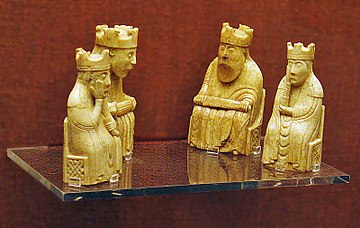Lewis chessmen

Lewis chessmen in the British Museum
|
|
| Material | Walrus ivory and whales' teeth |
|---|---|
| Created | 12th century |
| Discovered | 1831 Uig, Lewis, Scotland |
| Present location | |
The Lewis chessmen (Norwegian: Lewisbrikkene; Scots: Lewis chesmen) or Uig chessmen, named after the bay where they were found) are a group of distinctive 12th-century chess pieces, along with other gaming pieces, most of which are carved in walrus ivory. Discovered in 1831 on Lewis in the Outer Hebrides, Scotland, they may constitute some of the few complete, surviving medieval chess sets, although it is not clear if a set as originally made can be assembled from the pieces. When found, the hoard contained 93 artifacts: 78 chess pieces, 14 tablemen and one belt buckle. Today, 82 pieces are owned and usually exhibited by the British Museum in London, and the remaining 11 are at the National Museum of Scotland in Edinburgh.
The British Museum claims the chessmen were probably made in Trondheim, Norway, in the 12th century, although some scholars have suggested other Nordic countries. During that period, the Outer Hebrides, along with other major groups of Scottish islands, were ruled by Norway.
According to Dr. Alex Woolf, director of the University of St Andrews Institute for Medieval Studies, there are reasons for believing the pieces came from Trondheim:
Icelanders Gudmundur Thorarinsson and Einar Einarsson have proposed that the chessmen originated in Iceland, since only in Iceland were the bishops called that at that time, while in other countries they used a name unassociated with the church. They further claim that the pieces were carved by an artist known as Margret the Adroit. However, this is disputed by Woolf, who stated that the use of bishops originated in England, and by Norwegian chess historian and member of the Ken Whyld Association Morten Lilleøren.
...
Wikipedia
